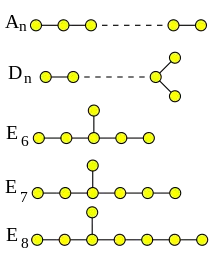du Val singularity
In algebraic geometry, a Du Val singularity, also called simple surface singularity, Kleinian singularity, or rational double point, is an isolated singularity of a complex surface which is modeled on a double branched cover of the plane, with minimal resolution obtained by replacing the singular point with a tree of smooth rational curves, with intersection pattern dual to a Dynkin diagram of A-D-E singularity type. They are the canonical singularities (or, equivalently, rational Gorenstein singularities) in dimension 2. They were studied by Patrick du Val[1][2][3] and Felix Klein.
The Du Val singularities also appear as quotients of by a finite subgroup of SL2; equivalently, a finite subgroup of SU(2), which are known as binary polyhedral groups.[4] The rings of invariant polynomials of these finite group actions were computed by Klein, and are essentially the coordinate rings of the singularities; this is a classic result in invariant theory.[5][6]
Classification

The possible Du Val singularities are (up to analytical isomorphism):
See also
References
- du Val, Patrick (1934a). "On isolated singularities of surfaces which do not affect the conditions of adjunction, Entry I". Proceedings of the Cambridge Philosophical Society. 30 (4): 453–459. doi:10.1017/S030500410001269X. S2CID 251095858. Archived from the original on 9 May 2022.
- du Val, Patrick (1934b). "On isolated singularities of surfaces which do not affect the conditions of adjunction, Entry II". Proceedings of the Cambridge Philosophical Society. 30 (4): 460–465. doi:10.1017/S0305004100012706. S2CID 197459819. Archived from the original on 13 May 2022.
- du Val, Patrick (1934c). "On isolated singularities of surfaces which do not affect the conditions of adjunction, Entry III". Proceedings of the Cambridge Philosophical Society. 30 (4): 483–491. doi:10.1017/S030500410001272X. S2CID 251095521. Archived from the original on 9 May 2022.
- Barth, Wolf P.; Hulek, Klaus; Peters, Chris A.M.; Van de Ven, Antonius (2004). Compact Complex Surfaces. Ergebnisse der Mathematik und ihre Grenzbereiche. 3. Teil (Results of mathematics and their border areas. 3rd Part). Vol. 4. Springer-Verlag, Berlin. pp. 197–200. ISBN 978-3-540-00832-3. MR 2030225. OCLC 642357691. Archived from the original on 2022-05-09. Retrieved 2022-05-09.
- Artin, Michael (1966). "On isolated rational singularities of surfaces". American Journal of Mathematics. 88 (1): 129–136. doi:10.2307/2373050. ISSN 0002-9327. JSTOR 2373050. MR 0199191.
- Durfee, Alan H. (1979). "Fifteen characterizations of rational double points and simple critical points". L'Enseignement mathématique. IIe Série. European Mathematical Society Publishing House. 25 (1): 131–163. doi:10.5169/seals-50375. ISSN 0013-8584. MR 0543555. Archived from the original on 2022-05-09. Retrieved 2022-05-09.
External links
- Reid, Miles, The Du Val singularities An, Dn, E6, E7, E8 (PDF)
- Burban, Igor, Du Val Singularities (PDF)